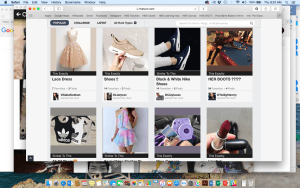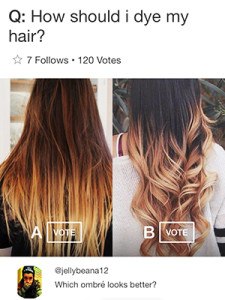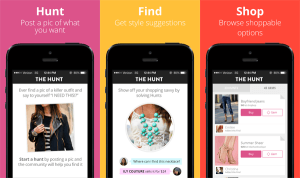The Hunt: Crowdsourcing Solutions for Fashion Missed-Connections

I first saw you crossing the street on 20th and Park by Gramercy Tavern. You were cropped and long sleeved with black and white stripes — possibly cashmere.
Last year, I was sitting by the window at Gramercy Tavern waiting for a couple of friends to show up for dinner. While waiting, I happened to notice a lady walk by with a very cute cropped turtleneck on and I thought, “that’s a very nice top, I want that.” Later that night, I remembered the turtleneck and I went to my computer and googled something like “striped crop sweater funnel neck.” I did an additional search on Polyvore and ShopStyle, and while my search returned hundreds of similar striped tops, the exact top never showed up – the fit and shape on the top had been very different and I was interested in finding the top I had seen in person specifically. After modifying my search phrase a few times, I finally came across an image of the top on an Australian fashion blogger – but no link to where I could actually purchase the item (her blog post that had the top in it was more a feature about the purse in the picture).
My personal example is probably some version of a relatively common frustration that many individuals experience – certainly for women who take lots of fashion cues from their every day environment. Rarely, however, do individuals chase down others to ask “where did you get that shirt?”
Enter The Hunt – or as I like to call it, the crowdsourcing platform/app for fashion missed-connections. The Hunt is a useful little tool geared towards  individual who are searching for a specific or “similar-to” item; while the app is primarily used for stalking down clothing items, the tool can also be used for various other accessories, home goods, etc. Rather than rely on Google or ShopStyle, The Hunt harnesses the power of user-generated product finds. Members can post images of products they would like to buy, and other users will help them hunt down where the product is actually sold. With over 4 million users and 3 million “hunts” started each week, approximately 50% of all hunts on the platform are “solved” within 24 hours.
individual who are searching for a specific or “similar-to” item; while the app is primarily used for stalking down clothing items, the tool can also be used for various other accessories, home goods, etc. Rather than rely on Google or ShopStyle, The Hunt harnesses the power of user-generated product finds. Members can post images of products they would like to buy, and other users will help them hunt down where the product is actually sold. With over 4 million users and 3 million “hunts” started each week, approximately 50% of all hunts on the platform are “solved” within 24 hours.
Value Creation
The Hunt keeps its value proposition relatively straightforward: this app helps you purchase that great dress you saw in person or that you saw while scrolling on Instagram, Tumblr, etc. The Hunt creates value through it’s ability to cater to a variety of purchasing needs and motivations; whether a user is searching for a similar or exact item match or a user who simply loves helping others find great deals, The Hunt provides that extra human touch that one could argue eludes complicated, algorithm based search results from Google and other engines.
Community Incentives
Tim Weingarten has been very vocal about the fact that he believes the key to a successful crowdsourcing community like The Hunt is an underlying intrinsic motivation behind each participant to actually spend time and help others find things to wear. “A lot of entrepreneurs would assume that if you pay people or give them cuts of the action or you make economic incentives that will help you build a community faster and will get people to do whatever you want them to do–sell things, buy things, create content, whatever,” he says. “We strongly believe that extrinsic motivations will backfire and that the most long-term sustainable franchises are built off of intrinsic motivation.”
Growth, Challenges & Value Capture
Since its start in 2011, The Hunt has branched out into “related” activities. Users can poll the community for real-time advice (e.g. “do you like shirt A or shirt B more?” or “does this outfit look good on me?”). While I imagine individuals are less prone to utilize the platform for opinions compared to  the deal-finding services (indeed there seem to be less posts/engagement in the “Help Style Me” category), I would also guess that The Hunt’s established community makes it easier for customers to entertain the idea of these related services — especially compared to other now-shuttered startups (GoTryItOn, Fashism, etc.) that focused solely on these “opinion-crowdsourcing services” from the start. The Hunt has focused on fostering strong community ties where individual trust can be built through helping users solve their “hunts” and through referring them to product they want. While the outcome remains to be seen, establishing this base-level of community trust should on some level help The Hunt avoid the market-for-lemons challenge its earlier predecessors where community opinions were maybe not trusted or valued by individual users.
the deal-finding services (indeed there seem to be less posts/engagement in the “Help Style Me” category), I would also guess that The Hunt’s established community makes it easier for customers to entertain the idea of these related services — especially compared to other now-shuttered startups (GoTryItOn, Fashism, etc.) that focused solely on these “opinion-crowdsourcing services” from the start. The Hunt has focused on fostering strong community ties where individual trust can be built through helping users solve their “hunts” and through referring them to product they want. While the outcome remains to be seen, establishing this base-level of community trust should on some level help The Hunt avoid the market-for-lemons challenge its earlier predecessors where community opinions were maybe not trusted or valued by individual users.
Probably more pressing, but certainly less unique, is the fact that The Hunt will need to figure out how to generate revenue. Aside from the same big data/consumer insight angle, an affiliate model will only take them so far as the primary point of The Hunt is not to sell the user product but to help her solve a problem – key for establishing credibility and continuing to build up its user base.




This is a cool concept. I wouldn’t downplay the big data angle, though. The consumer insights gleaned from this website will save companies a lot of money. First, they don’t have to conduct research on their own. Instead, they can gather information from a broad range of demographics and geographies using The Hunt. Second, they can forecast trends better, which can be costly in a customized business like fashion.
Aside from the data, I imagine now that the community is large enough, fashion companies will also pay to use the site to recommend their own products as a form of targeting advertising. However, The Hunt will need to monitor the corporate posts to make sure they are adding relevant information (i.e. not recommending boots when the user is looking for sneakers) or else the quality and trust of the site will decrease.
Either way, the Hunt’s unique crowdsourcing model has positioned it to be a lucrative acquisition for a Google or a Facebook, scrounging around to find any consumer information they can.
Thanks for the post! And now it got me interested to use it! However, I wonder how they can keep users coming back to the websites to contribute and help solve the questions. I understand the intrinsic motivation part, but they might only limit to people who are extremely passionate about fashion and thus lower the size of audience that could contribute. Maybe I am not their ideal customer segment, but wondered how you think about their effectiveness of solving the potential supply problem and what they could have done differently.
I haven’t heard of the Hunt, but I totally love this idea. Another reason that this is a great idea is to avoid the socially awkward ( and often deceitful) conversation of asking someone where their clothing is from. One potential issue that I can see is that certain retailers may try to buy popular search terms, and as a consequence dominate your search feed, leading you further away from solving your hunt. If the company can find a way to monetize while staying true to its core, then this app will certainly be appealing to indie designers and international brands as a mechanism to get their products on the radar of global consumers.
This is such a cool idea! I love that they have the potential to target both consumers and businesses, which makes the potential to scale much higher. The one thing that I worry about is crowd participation. You mentioned that 50% of hunts are solved within 24 hours. What percentage are solved ever? Its probably likely that if it isn’t solved in the first 24 hours, the chances of it being solved goes down. So if you end up with only 50 – 60% of total solved, then will that be enough incentive for people to continue to use it? Maybe because its better than having a 0% chance of finding the item, but it would be great if they could innovate to try to increase the solved rate. Maybe by create some technology that can sort through images and try to match your items.